新外研版初中英语七年级上册 Unit 1 I love history优质课公开课教案
- 格式:doc
- 大小:175.50 KB
- 文档页数:8
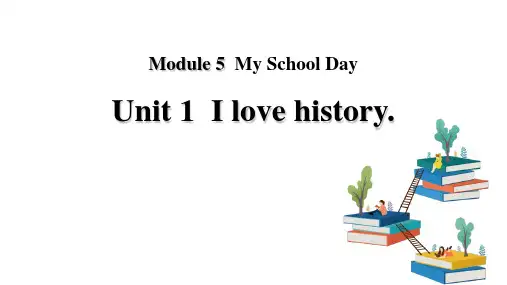
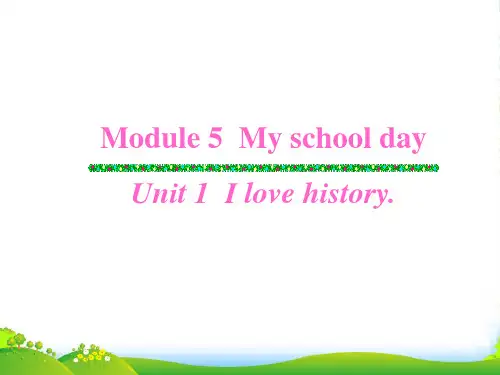
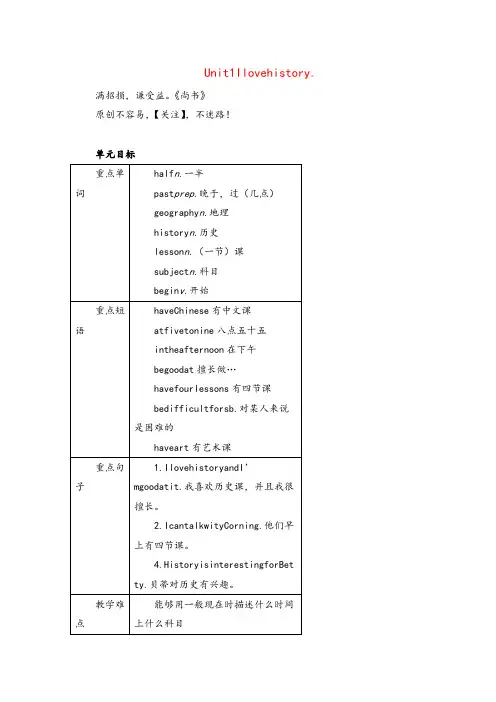
Unit1Ilovehistory. 满招损,谦受益。
《尚书》原创不容易,【关注】,不迷路!单元目标教学过程环节1新课导入教师可以利用教室里钟显示的时间进行问答:T:We?S1:It’stwelve.设计意图:本活动旨在激起学生的学习兴趣,引出模块的中心话题,起导入话题和展示词汇的作用。
为后面的听力作准备。
环节21.教师领读方框中的单词,并解释其含义。
2.学生观察图片信息,听录音并跟读。
3.两人一组活动,读出图中所示时间。
4.教师指导学生归纳不同的时间表达方式。
5.教师领读方框中的单词。
6.学生个体活动,完成图片和单词的匹配。
7.同伴之间核对答案,然后再全班核对。
8.教师简单介绍听力内容,然后让学生听第一遍并回答一个问题:“Worning.(2)现在是晚上8点半。
Nowitishalfpasteightintheevening.(3)你们的地理课是什么时候?Whenisyourgeographylesson?设计意图:引导学生运用结对练习法进行初步的语言实践,鼓励学生大胆开口,培养学生运用目标语言进行交际的能力。
板书设计Module5MyschooldayUnit1Ilovehistory.half,past,geogr aphy,history,begin, subject,lessonhaveChines,atfivet onine,intheafternoon,b egoodat,havefourlesson s,bedifficultforsb.,ha练习设计请完成本课对应训练!【素材积累】海明威和他的“硬汉形象”美国作家海明威是一个极具进取精神的硬汉子。
他曾尝试吃过蚯蚓、蜥蜴,在墨西哥斗牛场亮过相,闯荡过非洲的原始森林,两次世界大战都上了战场。
第一次世界大战时,19岁的他见一意大利士兵负伤,便冒着奥军的炮火上去抢救,结果自己也被炸伤了腿,但他仍背着伤员顽强前进。
突然间,炮停止,探照灯大亮,海明威终于回到阵地。

Module 5 Unit 1 I love historyⅠTeaching modelListening and speakingⅡTeaching methodInteractive approachⅢTeaching aims1. To understand time expressions and identify school subjects .2. To understand conversations about “a school day”.3. To process information of time and school subjects in the listening.4. To talk about one’s lessons with given information.ⅣTeaching ObjectivesKey vocabulary: half, past, o’clock, art, geography, history, IT, maths, (AM E math ), PE ( physical education ), lesson, then, difficult, love, subject, because, interesting, talk, begin, when Key structures: It’s six o’clock .It’s half past six .ⅤTeaching aidsTape recorder , OHP , video , a clockⅥTeaching StepsStep 1 Warming-up1. Show some pictures to explain time expressions.2. Listen and repeat the time.3. Ask and answer. What time is it?1.__________2.__________3.__________4.__________4. Call back the answer from the whole class and check the answer .Keys:1. It’s twelve o’clock2. It’s half past six3. It’s eleven o’clock4. It’s half past one5. Practice. Ask and answer. What time is it?Step 2 Practice1. Show some pictures of the subjects.2. Introduce the new words.3. Match the words with the pictures.4. Call back the answer from the whole class and check the answer .Answers:1. art2. Chinese3. English4. history5. maths6. IT7. geography8. PE5. Read the words.Step 3 Listen and read.1. Ask the students to read the conversation silently.2. Play the recording and ask the students to listen and read the conversation.3. Read the conversation.4. Act it out.Step 4 Read the dialogue Check (√) the true sentences.1. Read the dialogue again .2. Ask the students to choose the correct answers .1) Lessons begin at eight.2) They have four lessons in the morning.3) Maths is difficult for Betty.4) They have art on Monday.5) History is interesting for Betty.6) Tony’s favourite lesson is art.3) Ask the students to check with a partner .4. Play the recording again .Check the answers:Answers:1. √2. √3. ╳4. √5. √6. ╳Step 5 Listen and repeat.1. Play the recording once without stopping.2. Play the recording again and stop at the end of each line. Ask the whole class to repeat.3. Play the recording again and stop at the end of each line. Ask individual students to repeat.4. Ask the students to practice the sounds in pairs.Step 6 Answer the questions about you.1. Ask the students to work alone and to answer the questions.2. Ask them to check their answers in pairs.Step 7 Work in pairs .Talk about your lessons .1. Go through the language in the substitution table with the class.2. Pair them to ask and answer.I have / We have …I don’t have / We don’t have …I like / I don’t like …art , chemistry , Chinese , English , history , maths , science …3. Circulate and monitor their production.Step 8 Important and difficult points.1.时间Asking the time and responses(1)询问时间的表达法:What time is it?/What's the time?(2)时间的表达法:①整点: It's +基数词(one, two, …)+o'clock.e.g. It's twelve o'clock. 现在12点整。
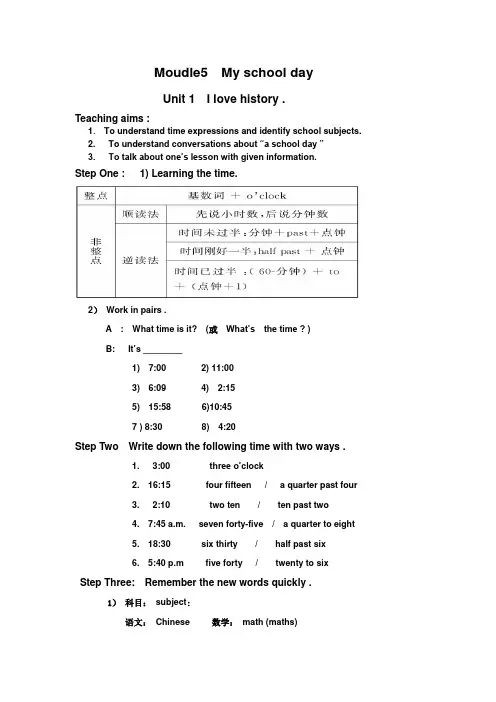
Moudle5 My school dayUnit 1 I love history .Teaching aims :1. To understand time expressions and identify school subjects.2. To unders tand conversations about “a school day ”3. To talk about one’s lesson w ith given information.Step One : 1) Learning the time.2)Work in pairs .A : What time is it? (或What’s the time ? )B: It’s ________1) 7:00 2) 11:003) 6:09 4) 2:155) 15:58 6)10:457 ) 8:30 8) 4:20Step Two Write down the following time with two ways .1. 3:00 three o’clock2. 16:15 four fifteen / a quarter past four3. 2:10 two ten / ten past two4. 7:45 a.m. seven forty-five / a quarter to eight5. 18:30 six thirty / half past six6. 5:40 p.m five forty / twenty to sixStep Three: Remember the new words quickly .1)科目:subject:语文:Chinese 数学:math (maths)英语: English 美术: art信息技术: IT 体育: PE音乐:music 历史: history地理:geographyI like _____because it’s very _______ but I don’tlike__becauseit’s very___ . .2)“ have +科目”表示“上……课”3 ) Find a subject to match the pictureStep Four Part 3:1. Listen and answer.1) What subject does Betty like best?She loves history.2) What is Tony’s favourite subject ?His favourite subject is Chinese.2. Listen again and check the true sentences.1). Lessons begin at eight. ()2). They have four lessons in the morning. ()3). Maths is difficult for Betty. ()4). They have art on Monday. ()5). History is interesting for Betty. ()6). Tony’s favourite lesson is art.()Answers : T T F TTF3. 1) Complete the table.(完成表格)2) Work in pairs :A: What time is your Chinese lesson ?B: I have Chinese at 8:00A: Do you like Chinese ?B: Yes , I do. / No, I don’t .(1) A: Why(为什么)do you like Chinese ?B : Because it’s very interesting.(2) A: Why don’t you like Chinese ?B: Because it’s very difficult.4. Read and recite them quickly .一)短语:1. 在星期一on Monday2. 在星期一下午on Monday afternoon3. 在下午in the afternoon4. 上语文课have Chinese5. 在8点钟at eight O’clock6. 与某人交谈talk with sb二)句子:1. 在星期一我们有什么课?What are our lessons on Monday ?2. 我们8点钟上语文。
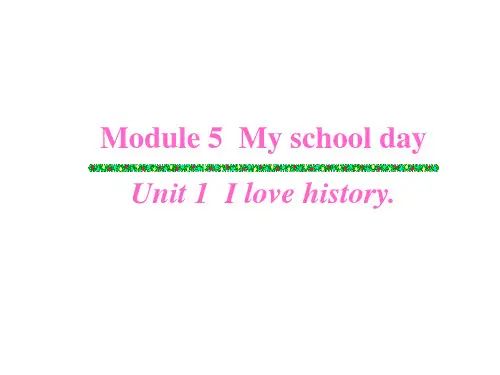
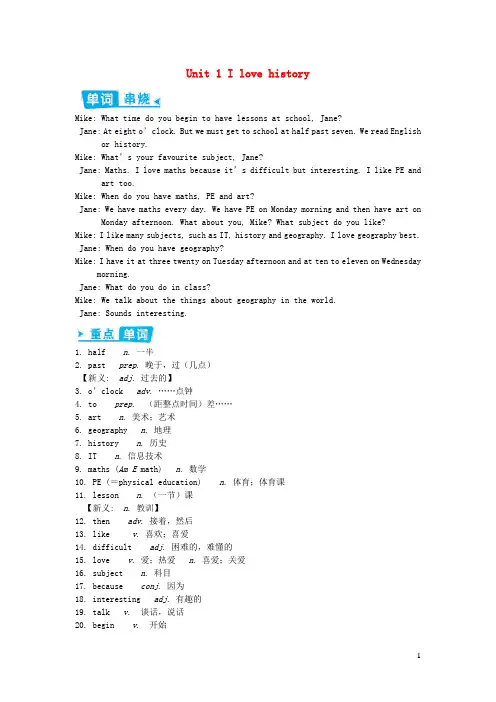
Unit 1 I love historyMike: What time do you begin to have lessons at school, Jane?Jane: At eight o’clock. But we must get to school at half past seven. We read English or history.Mike: What’s your favourite subject, Jane?Jane: Maths. I love maths because it’s difficult but interesting. I like PE and art too.Mike: When do you have maths, PE and art?Jane: We have maths every day. We have PE on Monday morning and then have art on Monday afternoon. What about you, Mike? What subject do you like?Mike: I like many subjects, such as IT, history and geography. I love geography best. Jane: When do you have geography?Mike: I have it at three twenty on Tuesday afternoon and at ten to eleven on Wednesday morning.Jane: What do you do in class?Mike: We talk about the things about geography in the world.Jane: Sounds interesting.1. half n.一半2. past prep. 晚于,过(几点)【新义: adj. 过去的】3. o’clock adv.……点钟4. to prep. (距整点时间)差……5. art n.美术;艺术6. geography n. 地理7. history n. 历史8. IT n.信息技术9. maths (Am E math) n.数学10. PE (=physical education) n.体育;体育课11. lesson n. (一节)课【新义: n.教训】12. then adv. 接着,然后13. like v. 喜欢;喜爱14. difficult adj.困难的,难懂的15. love v.爱;热爱n.喜爱;关爱16. subject n.科目17. because conj. 因为18. interesting adj. 有趣的19. talk v. 谈话,说话20. begin v. 开始21. when adv. 什么时候,何时1. half n.一半复数 halves2. difficult adj.困难的,难懂的→ difficulty n.困难;困境3. begin v.开始→ beginning n.开始;开端1. half past six 6点半2. have Chinese 上语文课3. at eight o’clock 在8点钟4. on Monday afternoon 在星期一下午5. in the morning/afternoon/evening 在上午/下午/晚上6. be good at…擅长……7. talk with 与……交谈1. ——(现在)几点了?——12点钟。


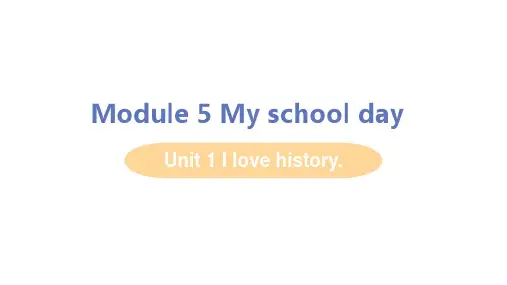
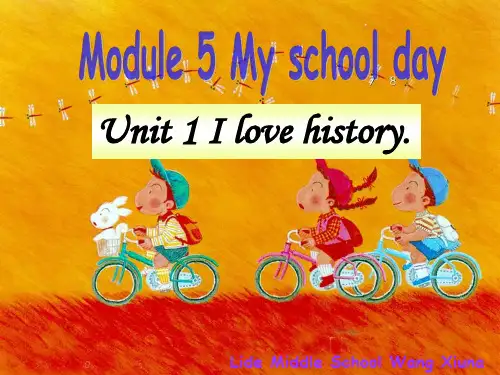
外研版(上)教案Module 5 My School Day一、学习目标:1. 重点单词:half, past, o’clock, to, art, geography, history, IT, maths, (Am E math ), PE ( physical education ), lesson, then, like, difficult, love, subject, because, interesting, talk, begin, when, weekday, house, start, work, break, evening, watch, do, homework, bed, sleep, park, busy, wash, face, minute2. 重点短语:go to school,get up, have breakfast, have lunch, go home, have dinner, go to bed, go to sleep3.重点句子:1) I love history.2) It’s twelve o’clock .3) We h ave Chinese at eight o’clock.4) We don’t have maths.5) —Do you like maths?—Yes, I do.6) In the evening, I watch TV and have dinner with my family.7) I get up at half past seven in the morning and have breakfast.8) I drink Cola or water.二、重点及难点:1.时间的表达方式。
2.用在时间前的介词(at , in , on)的用法。
3.一般现在时的陈述句形式(主语为主语为I, they, we, you)。
4.and 连接的两个简单句。
三、教学设计:Unit 1 I love history.ⅠTeaching modelListening and speakingⅡTeaching methodInteractive approachⅢTeaching aims1. To understand time expressions and identify school subjects .2. To understand conversations about “a school day”.3. To process information of time and school subjects in the listening.4. To talk about one’s lessons with given information.ⅣTeaching ObjectivesKey vocabulary: half, past, o’clock, art, geography, history, IT, maths, (AM E math ), PE ( physical education ), lesson, then, difficult, love, subject, because,interesting, talk, begin, whenKey structures: It’s six o’clock .It’s half past six .ⅤTeaching aidsTape recorder , OHP , video , a clockⅥTeaching StepsStep 1 Warming-up1. Show some pictures to explain time expressions.2. Listen and repeat the time.3. Ask and answer. What time is it?1.__________2.__________3.__________4.__________4. Call back the answer from the whole class and check the answer .Keys:1. It’s twelve o’clock2. It’s half past six3. It’s eleven o’clock4. It’s half past one5. Practice. Ask and answer. What time is it?Step 2 Practice1. Show some pictures of the subjects.2. Introduce the new words.3. Match the words with the pictures.4. Call back the answer from the whole class and check the answer . Answers:1. art2. Chinese3. English4. history5. maths6. IT7. geography8. PE 5. Read the words.Step 3 Listen and read.1. Ask the students to read the conversation silently.2. Play the recording and ask the students to listen and read the conversation.3. Read the conversation.4. Act it out.Step 4 Read the dialogue Check (√) the true sentences.1. Read the dialogue again .2. Ask the students to choose the correct answers .1) Lessons begin at eight.2) They have four lessons in the morning.3) Maths is difficult for Betty.4) They have art on Monday.5) History is interesting for Betty.6) Tony’s favourite lesson is art.3) Ask the students to check with a partner .4. Play the recording again .Check the answers:Answers:1. √2. √3. ╳4. √5. √6. ╳Step 5 Listen and repeat.1. Play the recording once without stopping.2. Play the recording again and stop at the end of each line. Ask the whole class to repeat.3. Play the recording again and stop at the end of each line. Ask individual students to repeat.4. Ask the students to practice the sounds in pairs.Step 6 Answer the questions about you.1. Ask the students to work alone and to answer the questions.2. Ask them to check their answers in pairs.Step 7 Work in pairs .Talk about your lessons .1. Go through the language in the substitution table with the class.2. Pair them to ask and answer.I have / We have …I don’t have / We don’t have …I like / I don’t like …art , chemistry , Chinese , English , history , ma ths , science …3. Circulate and monitor their production.Step 8 Important and difficult points.1.时间Asking the time and responses(1)询问时间的表达法:What time is it?/What's the time?(2)时间的表达法:①整点:It's +基数词(one, two, …)+o'clock.e.g. It's twelve o'clock. 现在12点整。
②几点过几分:It's +分+past+小时(基数词)(基数词)e.g. It's twenty past five. 现在5:20。
③几点差几分:It's+分+to+小时(基数词)(基数词)e.g. It's twenty to six. 现在5:40。
/现在6点差20。
注意:A、介词to, past前的分钟通常在30之内,但几点半,通常用介词past.e.g. It's half past six. 现在6:30。
B、时间的表达有一种简单的方法:即直接用小时+分钟(基数词)(基数词)e.g. It's eight twenty –five 现在8:25。
Step 9 Do exercises:A、用英语写出下列时间6:00 _______________ 8:00 _______________6:30 _______________ 7:45 _______________8:01 _______________ 1:15 _______________2:30 _______________ 3:45 _______________7:20 _______________ 9:40 _______________ 8:15 _______________ 5:10 _______________6:35 _______________ 9:55 _______________ Answers:6:00 six o’clock8:00 eight o’clock6:30 six thirty 7:45 seven forty-five8:01 one past eight 1:15 a quarter past one2:30 half past two 3:45 a quarter to four7:20 twenty past seven 9:40 twenty to ten8:15 a quarter past eight 5:10 ten past five6:35 twenty-five to seven 9:55 five to tenB.单词拼写:1. It’s ten ___________ (钟)now .2. I like ___________ (数学), What about you, Tony?3. I am good at ___________ (地理).4. W e don’t have ___________ (历史) on Friday afternoon.5.IT is my favourite ___________ (科目) because it’s very interesting.6. At twenty ___________ (过) ten we have English.7. We have two _________ (课) in the afternoon.8. We have ___________ (语文) at nine o’clock in the morning.Keys:1. o’clock 2. maths 3. geography 4. history 5. subject6. past7. lessons8. ChineseC、翻译下列句子:1.我们11:00上美术课。